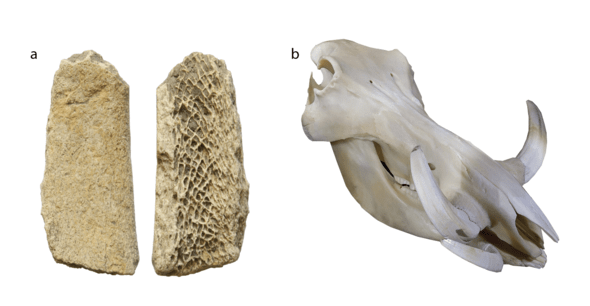Quality Considerations for Bone Samples
Bones and teeth are relatively common within the archaeological and paleontological record due to the tendency for high preservation after burial. However, burial conditions, burning/charring and diagenetic processes can vastly impact the quality of sample for stable and radiogenic isotope analysis. Whilst ideally one would select bones from optimal environments (sheltered cool, dry conditions), information on the burial conditions is not always readily available. Hence, visual inspection of samples can help one narrow down the highest quality samples for isotopic analysis.
Structural Integrity of Bone Surface
One of the basic assumptions of isotopic analyses is that the chemical composition of a bone/tooth has not changed since death and burial of the organism. The composition of bones/teeth can change when elements from water or other surrounding mediums are filtered into the structure (uptake) and/or elements from the bone structure are leached. Typically this is more likely to occur if the bones have porous, degraded surfaces with cracks.

Two of the animal bone fragments above (a: demonstrate relatively low structural integrity (Cambridgeshire County Council, 2012) . The bone is quite weathered with a porous, hollow exposed interior – not ideal for isotopic analysis given the likelihood of chemical changes. On the other hand, the warthog (Phacochoerus africanus) skull (b: shows a smooth, in-tact surface with little to no cracks – demonstrating a more ideal bone structure (Didier Descouens, 2011).
Bone Colour
The color of a bone can provide clues of heat-related traits and likelihood of chemical alteration. For example, a bone that has not been altered by heat will have no color change – it will remain an off-white demonstrating no thermal alteration. If a bone has been exposed to heat, it will have a deep brown color – often found adjacent to a charred area which will appear black (Keogh et al. 2015). In the image below (Auckland Museum, 2018) the transition from unaltered to burnt to charred is clearly visible on a chisel bone sample. Finally, if a bone is gray, white or blue in color, it is likely in a calcined state wherein all organic carbon has been burnt away.

It is important to note that the bone color alone cannot predict the temperature of burning, as that has been proven to vary depending on the pH conditions during burial and whether combustion or charred occurred (Reidsma, 2022); darkening tends to occur at lower temperatures in low pH conditions.
Case Studies
In recent years, researchers have been exploring the impacts of bone/tooth quality on stable isotope fractionation and trace element content. For example, Maurer et al. (2014) investigated how post-mortem diagenetic processes impacted a series of elements as well as stable oxygen and carbon isotopes (δ13C and δ18O) in carbonate buried in two main habitat types in Mauritania and Mali: a periodically flooded area and a relatively drier area. They found that bones buried in the flooded area exhibited more structural damage, secondary mineral precipitation in pore spaces and a higher degree of intra-skeletal variability in trace elements and stable isotopic composition than those from the dry environment. This study demonstrates that the structural integrity of a bone can provide clues into whether they will be good candidates for geochemical analyses, however, visual inspection is not always sufficient. For example, Jacob et al. (2018) highlighted the difficulties associated with predicting the level of collagen using microscopic analysis alone. The authors analyzed % nitrogen within bone samples as a proxy for protein content, predicting a threshold required for radiocarbon dating of bones. Though this pre-screening method is not foolproof (yielding a 72% accurate prediction of collagen threshold), it provides a more accurate indication of bone/tooth suitability than color and structural integrity alone.
Regardless of the geochemical analysis planned for bone/tooth samples, the visual inspection of surface pores, cracks, hardness and color can provide clues about the burial environment (humidity, pH, burning/charring) and likelihood of isotopic results that are fit for purpose. Whilst this method is not infallible, it can assist in subsetting potential samples for analysis.
References
- Jacob, E., Querci, D., Caparros, M., Ruiz, C.B., Higham, T. and Devièse, T., 2018. Nitrogen content variation in archaeological bone and its implications for stable isotope analysis and radiocarbon dating. Journal of Archaeological Science, 93, pp.68-73.
- Keough, N., L’Abbé, E.N., Steyn, M. and Pretorius, S., 2015. Assessment of skeletal changes after post-mortem exposure to fire as an indicator of decomposition stage. Forensic science international, 246, pp.17-24.
- Maurer, A.F., Person, A., Tütken, T., Amblard-Pison, S. and Ségalen, L., 2014. Bone diagenesis in arid environments: An intra-skeletal approach. Palaeogeography, Palaeoclimatology, Palaeoecology, 416, pp.17-29.
- Reidsma, F.H., 2022. Laboratory-based experimental research into the effect of diagenesis on heated bone: implications and improved tools for the characterisation of ancient fire. Scientific Reports, 12(1), p.17544.
Bone image 1a:
https://commons.wikimedia.org/wiki/File:Unknown_Date,_Animal_Bone_Fragments_(FindID_436319).jpg
Bone image 1b:
https://commons.wikimedia.org/wiki/File:Phacoch%C3%A8re9.jpg
Bone image 2:
https://commons.wikimedia.org/wiki/File:Chisel,_bone_(AM_1945.56-2).jpg
